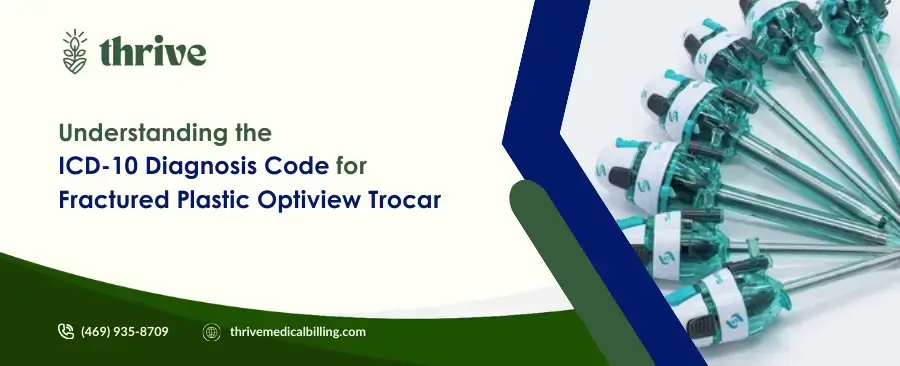In medical coding and surgical practice, accurately documenting complications from surgical tools is critical. One specific issue is the fracture of a plastic Optiview trocar, a device used in minimally invasive surgeries, which may lead to retained fragments or other complications. This blog post provides clear, detailed information on the appropriate ICD-10 diagnosis code for a fractured plastic Optiview trocar, related codes for complications, and guidance on proper documentation to support healthcare providers, coders, and billing specialists.
What Is an Optiview Trocar?
An Optiview trocar, part of Ethicon’s ENDOPATH XCEL line, is a bladeless surgical tool used in laparoscopic procedures to create a portal for inserting instruments into the body cavity. Its OPTIVIEW technology allows visualization during insertion to minimize tissue damage. Fractures in these plastic trocars can occur due to material stress, improper handling, or manufacturing defects, potentially leaving plastic fragments in the patient’s body. Such incidents require precise coding to document the complication and guide treatment.
The Primary ICD-10 Diagnosis Code for Fractured Plastic Optiview Trocar
The most appropriate ICD-10 code for a fractured plastic Optiview trocar, particularly when it results in retained fragments, is Z18.2 - Retained plastic fragments. This billable code falls under the category of retained foreign body fragments (Z18) and is used when plastic pieces from a broken surgical device, like the Optiview trocar, remain in the body.
Why Z18.2?
- Material Specificity: Z18.2 directly addresses retained plastic fragments, making it suitable for a fractured plastic trocar.
- Application: This code applies when imaging (e.g., X-ray or CT) confirms plastic remnants post-procedure.
- 2025 Relevance: Z18.2 is valid for reimbursement in the latest ICD-10-CM guidelines and is used for complications without acute infection or inflammation.
If the fracture occurs during surgery and results in immediate retention, consider T81.500A - Unspecified complication of foreign body accidentally left in body following surgical operation, initial encounter. However, Z18.2 is more specific for plastic fragments.
Related ICD-10 Codes for Complications
Fractured trocars can lead to various issues. Below are additional codes that may apply, depending on the clinical scenario:
| ICD-10 Code | Description | When to Use |
|---|---|---|
| T81.500A | Unspecified complication of foreign body accidentally left in body following surgical operation, initial encounter | For acute retention of any foreign body during surgery, including trocar fragments. |
| W44.B9 | Other plastic object entering into or through a natural orifice | If the fractured piece enters the body unintentionally via a surgical site. |
| Y81.3 | Surgical instruments, materials and general- and plastic-surgery devices (including sutures) associated with adverse incidents | For documenting adverse events involving surgical tools like trocars. |
| Z47.2 | Encounter for removal of internal fixation device | If surgical removal of the fragment is needed, though trocars aren’t fixation devices. |
| Z18.9 | Retained foreign body fragments, unspecified material | A fallback if the material isn’t confirmed as plastic. |
Pair these codes with external cause codes (e.g., Y92 for place of occurrence) for complete documentation.
How to Document and Bill Using These Codes
Accurate documentation ensures proper coding and billing:
- Clinical Notes: Record the procedure (e.g., laparoscopic surgery), how the fracture occurred, and confirmation via imaging.
- Code Sequencing: List the primary diagnosis (e.g., Z18.2) first, followed by secondary codes for related complications.
- Billing Tips: Z18.2 supports claims for follow-up care or fragment removal. Verify payer requirements, as some may need prior authorization for extraction procedures.
- Avoid Errors: Don’t confuse with codes for unrelated fractures, like hip fractures (e.g., S72.141A), which may appear in searches due to “trochanter” misspellings.
Risks and Prevention of Trocar Fractures
A fractured trocar can cause complications like infection, organ damage, or extended hospital stays. While Optiview trocars are designed for safe insertion, risks remain. Prevention includes:
- Checking devices for recalls or expiration dates.
- Using proper lubrication and handling techniques.
- Employing visualized entry to reduce excessive force.
Conclusion
The primary ICD-10 diagnosis code for a fractured plastic Optiview trocar is Z18.2 - Retained plastic fragments, with T81.500A as an alternative for acute retention cases. Accurate coding and documentation support effective patient care and billing. Always consult the latest ICD-10-CM guidelines or a certified coder for complex cases.
FAQs
- What if no fragments are retained?
Use Y81.3 to document the adverse incident without retention. - Is Z18.2 billable?
Yes, it’s a specific, billable code for reimbursement purposes. - Are there recalls for Optiview trocars?
Past recalls have addressed issues like leaking or lubrication problems. Check FDA databases for updates.








